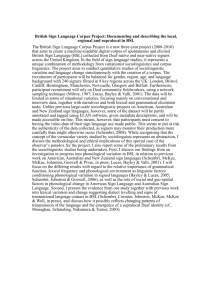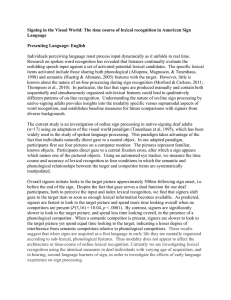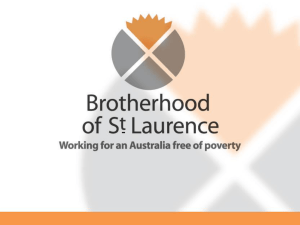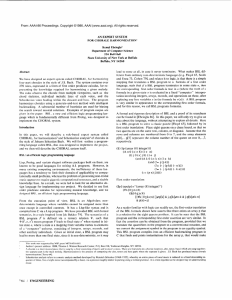British Sign Language (BSL) dialects in contact: Investigating the patterns of accommodation and language change
advertisement
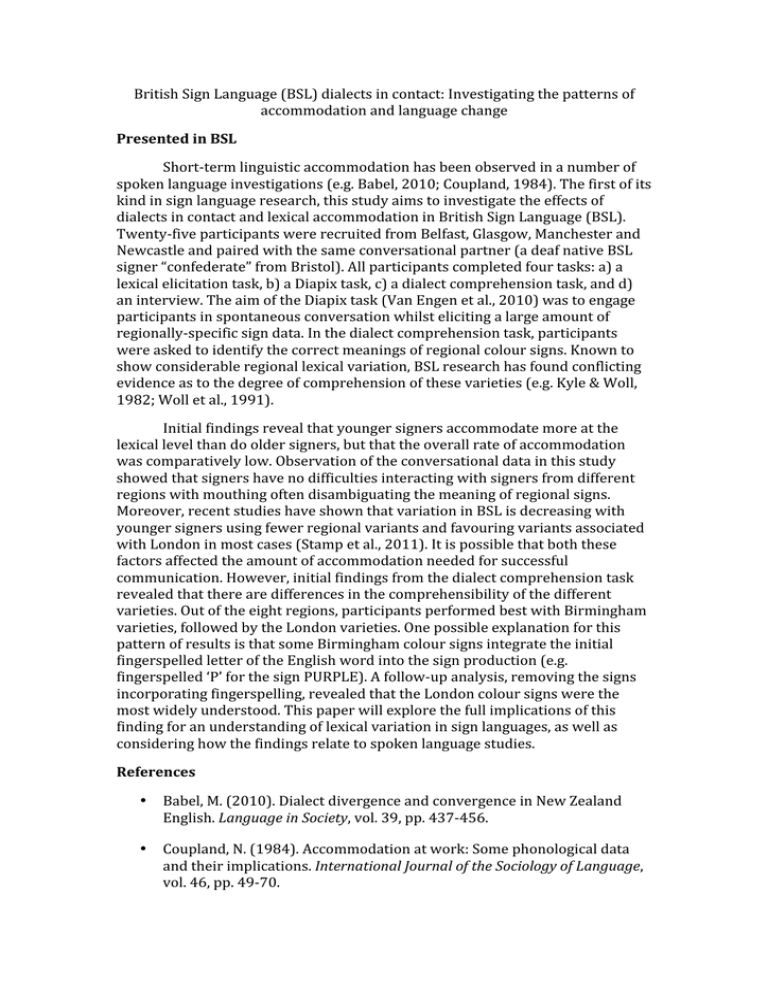
British Sign Language (BSL) dialects in contact: Investigating the patterns of accommodation and language change Presented in BSL Short‐term linguistic accommodation has been observed in a number of spoken language investigations (e.g. Babel, 2010; Coupland, 1984). The first of its kind in sign language research, this study aims to investigate the effects of dialects in contact and lexical accommodation in British Sign Language (BSL). Twenty‐five participants were recruited from Belfast, Glasgow, Manchester and Newcastle and paired with the same conversational partner (a deaf native BSL signer “confederate” from Bristol). All participants completed four tasks: a) a lexical elicitation task, b) a Diapix task, c) a dialect comprehension task, and d) an interview. The aim of the Diapix task (Van Engen et al., 2010) was to engage participants in spontaneous conversation whilst eliciting a large amount of regionally‐specific sign data. In the dialect comprehension task, participants were asked to identify the correct meanings of regional colour signs. Known to show considerable regional lexical variation, BSL research has found conflicting evidence as to the degree of comprehension of these varieties (e.g. Kyle & Woll, 1982; Woll et al., 1991). Initial findings reveal that younger signers accommodate more at the lexical level than do older signers, but that the overall rate of accommodation was comparatively low. Observation of the conversational data in this study showed that signers have no difficulties interacting with signers from different regions with mouthing often disambiguating the meaning of regional signs. Moreover, recent studies have shown that variation in BSL is decreasing with younger signers using fewer regional variants and favouring variants associated with London in most cases (Stamp et al., 2011). It is possible that both these factors affected the amount of accommodation needed for successful communication. However, initial findings from the dialect comprehension task revealed that there are differences in the comprehensibility of the different varieties. Out of the eight regions, participants performed best with Birmingham varieties, followed by the London varieties. One possible explanation for this pattern of results is that some Birmingham colour signs integrate the initial fingerspelled letter of the English word into the sign production (e.g. fingerspelled ‘P’ for the sign PURPLE). A follow‐up analysis, removing the signs incorporating fingerspelling, revealed that the London colour signs were the most widely understood. This paper will explore the full implications of this finding for an understanding of lexical variation in sign languages, as well as considering how the findings relate to spoken language studies. References • Babel, M. (2010). Dialect divergence and convergence in New Zealand English. Language in Society, vol. 39, pp. 437‐456. • Coupland, N. (1984). Accommodation at work: Some phonological data and their implications. International Journal of the Sociology of Language, vol. 46, pp. 49‐70. • Kyle, J. G. & Allsop, L. (1982). Deaf people and the community. University of Bristol, School for Education: centre for Deaf studies, Bristol. • Stamp, R., Schembri, A., Fenlon, J., & Rentelis, R. (2011, 4 August 2011). Lexical variation and change in British Sign Language (BSL). Paper presented at the Methods in Dialectology 14, University of Western Ontario, London, Canada. • Van Engen, K. J., Baese‐Berk, M., Baker, R. E., Choi, A., Kim, M., & Bradlow, A. R. (2010). The Wildcat corpus of native‐ and foreign‐accented English: Communicative efficiency across conversational dyads with varying language alignment profiles. Language and speech, vol. 53, no. 4, pp. 510‐ 540. • Woll, B., Sutton‐Spence, R., & Allsop, L. (1991). Variation and Recent Change in British Sign Language: Final Report to the ESRC. University of Bristol, Bristol.

